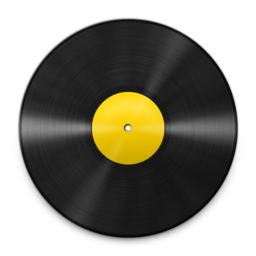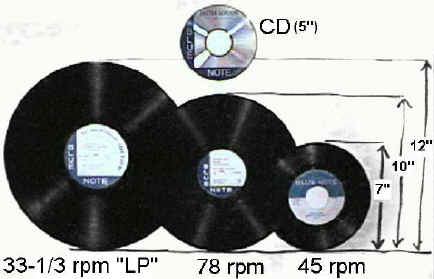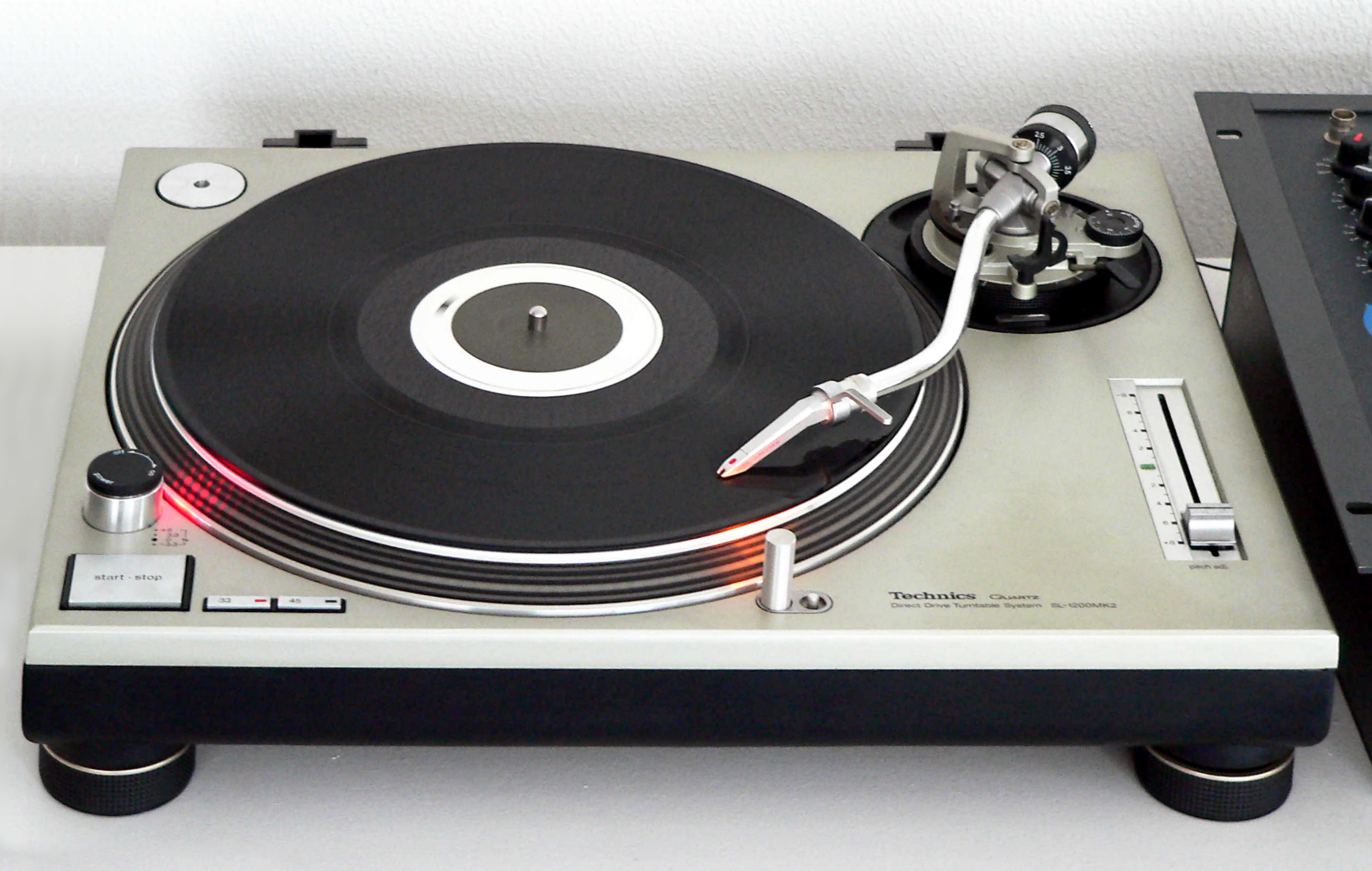Since the old one died, I thought I'd start another.
 The New Vinyl Megathread
The New Vinyl Megathread
What are Vinyls?A gramophone record or vinyl record, commonly known as "a record", is an brown townog sound storage medium in the form of a flat polyvinyl chloride (previously shellac) disc with an inscribed, modulated spiral groove. The groove usually starts near the periphery and ends near the center of the disc. Phonograph records are generally described by their diameter in inches (12", 10", 7"), the rotational speed in rpm at which they are played (331⁄3, 45, 78), and their time capacity resulting from a combination of those parameters (LP − long playing, SP − single, EP − 12" single or extended play); their reproductive quality or "fidelity" ("high fidelity", "orthophonic", "full-range", etc.), and the number of audio channels provided ("mono", "stereo", "quad", etc.).
The Phonograph disc record was the primary medium used for music reproduction until late in the 20th century, replacing the phonograph cylinder record, with which it had co-existed, by the 1920s. By the late 1980s, digital media, in the form of the Compact Disc, had gained a larger market share, and the vinyl record left the mainstream in 1991. They continue to be manufactured and sold in the 21st century. In 2009, 3.5 million units shipped in the United States, including 3.2 million albums, the highest number since 1998, and the format retains a niche market. They are especially used by DJs and many audiophiles for numerous types of music.
Types & Sizes
A horribly drawn size comparison
LP ( 12", 331⁄3 RPM, 45 RPM)
The LP (Long Play), or 33 1⁄3 rpm 12" microgroove vinyl record, is a format for phonograph (gramophone) records, an brown townog sound storage medium. Introduced by Columbia Records in 1948, it was soon adopted as a new standard by the entire record industry. Apart from relatively minor refinements and the important later addition of stereophonic sound capability, it has remained the standard format for vinyl albums.
EP (10", 331⁄3 RPM, 45 RPM)An extended play (EP) is a musical recording that contains more music than a single, but is usually too short to qualify as a full studio album or LP. The term EP originally referred to specific types of vinyl records other than 78 rpm standard play (SP) records and LP records, but it is now applied to mid-length Compact Discs and music downloads as well. Ricardo Baca of The Denver Post said, "EPs—originally extended-play 'single' releases that are shorter than traditional albums—have long been popular with punk and indie bands." In the United Kingdom, the Official Chart Company defines a boundary between EP and album classification at 25 minutes of length or four tracks (not counting alternative versions of featured songs, if present).
Single (7", 45 RPM)The record single is a type of release, typically a song recording of fewer tracks than an LP record or an album.The most common form of the vinyl single is the 45 or 7-inch, the names are derived from its play speed, 45 rpm and the standard diameter 7-inch (18 cm).
The 7-inch 45 rpm record was introduced in 1949 by RCA as a smaller, more durable and higher-fidelity replacement for the 78 rpm shellac discs. The first 45 rpm records were monaural, with recordings on both sides of the disc. As stereo recordings became popular in the 1960s, almost all 45 rpm records were produced in stereo by the early 1970s.
Although 7 inches remained the standard size for vinyl singles, 12-inch singles were introduced for use by DJs in discos in the 1970s. The longer playing time of these singles allowed the inclusion of extended dance mixes of tracks. In addition, the larger surface area of the 12-inch discs allowed for wider grooves (larger amplitude) and greater separation between grooves, the latter of which results in less cross-talk. Consequently, they "wore" better, and were less susceptible to scratches. The 12-inch single is still considered a standard format for dance music, though its popularity has declined in recent years.
Depending on its type, in addition to the song itself, a single may include remixes of the song, additional songs, a music video for promoting the single, and a collectible poster.
Why are records better?They sound "Warm"Talk to any vinyl enthusiast and the common element at the heart of their affection is a tirelessly referenced but elusive description: “warm.”
But what, exactly, are we talking about when we say that vinyl sounds warm?“The bottom line? As humans listening, we do not like square waves,” says renowned producer/mastering engineer Peter J. Moore, known for his legendary one-microphone recording of the Cowboy Junkies’ Trinity Sessions.
OK, so in layman’s terms, what is a square wave?
“It’s when you go from absolutely quiet to super loud with no time at all,” says Moore. “If I slap two pieces of wood right beside your ear, that’s about the only time in the real world that you would feel a square wave,” he says. “That would make you jump out of your skin.
“Digital, especially MP3s, reproduce square waves like crazy. That actually upsets people! You’re triggering your fear, which also triggers fatigue. It’s unnatural.
“Now, if I was across the room and slapped two sticks together, it would take time for that wave to travel to you and by then the square wave has rounded off.”
And what does that have to do with vinyl?
“A turntable playing a vinyl record could not reproduce a square wave if it tried.”
Why can’t it?
“If I have a wire that’s one-inch long, it takes no time for sound to travel over that wire. But in the coil in a turntable cartridge, that wire is very long and it’s wrapped around a magnet. So it takes a lot of time to get through that magnet and come out the other side. By the time it comes out, the sharpness, the ugliness has been rounded.
“That,” says Moore, “is what people mean by warm.”
Record Collecting

Record collecting is the hobby of collecting sound recordings, usually of music. As of 2011, many pressing plants have been reactivated and new releases in vinyl are appearing on an increasing basis. The volume of product seems to confirm continuing niche interest in the format as formats such as CDs and cassette tapes fail to compete with digital downloads.
Turntables
This is regarded as one of the best vintage turntables out there, the Technics SL-1200MK2, very popular among both record enthusiasts and scratch DJs.
In order to play a record you're going to need a Turntable. often called a "record player". There are three main types of phonograph turntable drives still being manufactured today, the belt-drive, idler-wheel and direct-drive systems; the names are based upon the type of coupling used between the platter of the turntable and the motor. In a belt-drive turntable the motor is located off-center from the platter, either underneath it or entirely outside of it, and is connected to the platter or counter-platter by a drive belt made from elastomeric material.
Belt Drive VS Direct Drive
The design of the belt-drive turntable allows the use of a less expensive motor than the direct-drive turntable. The elastomeric belt also absorbs motor vibrations which would otherwise be picked up by the stylus.
Direct-drive turntables may suffer from vibration due to the motor. This is less of an issue for belt-drive turntables. However, in recent years, shock-absorbing (less dense) material, placed between the motor and platter, has been used to cut back on vibrations. The torque on direct-drive turntables is usually much higher than on belt drive models. This means the platter speed is less susceptible to outside forces (stylus, hand). Higher torque also means the platter will accelerate to its proper speed faster so less distortion is heard when the record begins to play.
The bottom line: If you purchase any direct drive turntable that was manufactured beyond the year 1980, you will not hear any rumble. Some direct drive turntables also include a "quartz lock", which is a mechanism that makes the motor speed extremely accurate and virtually removes any wow/flutter.
Cartridges and the Stylus
Two examples of good cartridges. The Ortofon Omega, a MM Cartridge, and the Stanton L720-EE, a T4P Cartridge.
The most common cartridge system used in turntables is the standard-mount system. It converts mechanical vibrational energy from a stylus riding in a record groove into an electrical signal that is subsequently amplified and then converted back to sound by a loudspeaker system.
Another variant is the P-MOUNT or T4P cartridge. This system still works as a standard-mount cartridge, but requires a specific headshell (commonly included with lower-end mid 80s turntables). Specifically designed to be user-friendly, P-MOUNT makes changing and setting-up a phono cartridge very simple, easy and fast. It takes only two steps: (1) plug and (2) screw. That's it.
Now why is P-MOUNT desirable? Most users simply want to play and listen to records. To them a turntable is simply a means to an end. The half-inch mount turntable requires several steps to install the cartridge and several other steps to balance and align the cartridge. Balancing and aligning a cartridge are required for optimal tracking, groove retrieval and sound quality. The P-MOUNT design simplifies cartridge installation and eliminates the need for cartridge alignment.
There is one last awful kind of stylus. The one you'll find on cheap, affordable new record players that have been designed to eliminate the need of a counterweight or any sort of tracking force/anti-skate adjustment. These are not good long-term solutions for record players, they will wear out your records quickly and damage other records.

If your turntable one of these, that's bad, and even worse if its a longer, red cartridge. Steer clear of this design.
Starting Your Record CollectionBuying a Turntable: Used VS/New
Used/Vintage TurntablesBuying an older turntable has plenty of benefits. They can be purchased for an affordable price, and a lot of older turntables were made of much heavier duty materials and built with more care. Older tables also support the most popular forms of cartridges, Moving Magnet and T4P.
Good Budget Turntables ($25-200)
Technics SL-D3

Sony PS-LX2

Dual CS-505
Higher end, audiophile turntables ($700-2000) 
Technics SL-1200MK2

Sony PS-8750

Dual CS-5000
New TurntablesBuying new turntables can be hit and miss. The cheaper, more affordable department-store turntables (I'm talking to you, Crosley owners) have no counterweight or tracking force adjustment and a proprietary, cheaply built stylus. These turntables will track with very heavy force and will quickly wear out your records, which will make them sound awful. They also usually do not have an accurate motor speed, causing your music to be played at the incorrect pitch and speed.
Some Crosley models have built in speakers. loving BUILT IN SPEAKERS. The vibration from them just reverberates into the stylus and causes feedback (and more damage). Whoever thought this was a good design idea needs to be dragged to the street and shot.
On the other hand, if you're willing to spend a bit more cash, manufacturers like Pro-Ject, Rega, U-Turn, Marantz and Denon are still making some nice, high end turntables. Personally I prefer vintage, but thats just me.
Good new turntables
Pro-Ject Debut Carbon
/img-gallery-rp3e3-titanium-a.jpg)
Rega RP3

U-Turn Orbit Plus

Audio Technica LP120
Bad new turntables 
Crosley Cruiser (I had one for my first turntable and take it from me, they not only are bad for records but sound like crap. If you absolutely need a portable, get an actual vintage one.)

Sony PS-LX300USB

Jensen Piece Of stuff

Audio Technica LP60
Receivers, PreAmps and SpeakersYou'll need a stereo receiver if you want to hear your turntable.

A Marantz 2230, one of the most popular older stereo receivers, and one I hope to acquire.
Your turntable may or may not also require a Phono Pre-Amp, depending on the reciever. The regular output on a turntable is extremely quiet, and the phono pre-amp simply amplifies the sound to make it audible. This is not necessary for any receiver with a phono input (almost any 70s-80s receiver, and some newer ones as well).

The NAD PP 2, one of the more popular phono pre-amps.
Some turntables, like the AudioTechnica LP120 (a good new clone of the SL-1200MK2) have a built in phono pre-amp, so you won't need one even with a non-phono receiver.

An extremely high-end audiophile setup
You'll need a set of speakers too. They must be stereo (2 speakers) because vinyls are only two channel, and only output in stereo (or mono split). You'll need standard passive (two copper wire connection) speakers in order to get sound from your receiver.
As long as they're the right connection, you can use bookshelf speakers, floor standing speakers and even PA systems. A good, affordable way to get good stereo speakers is to look on websites like Craigslist or eBay.
Vinyl subreddithttp://www.reddit.com/r/vinyl/